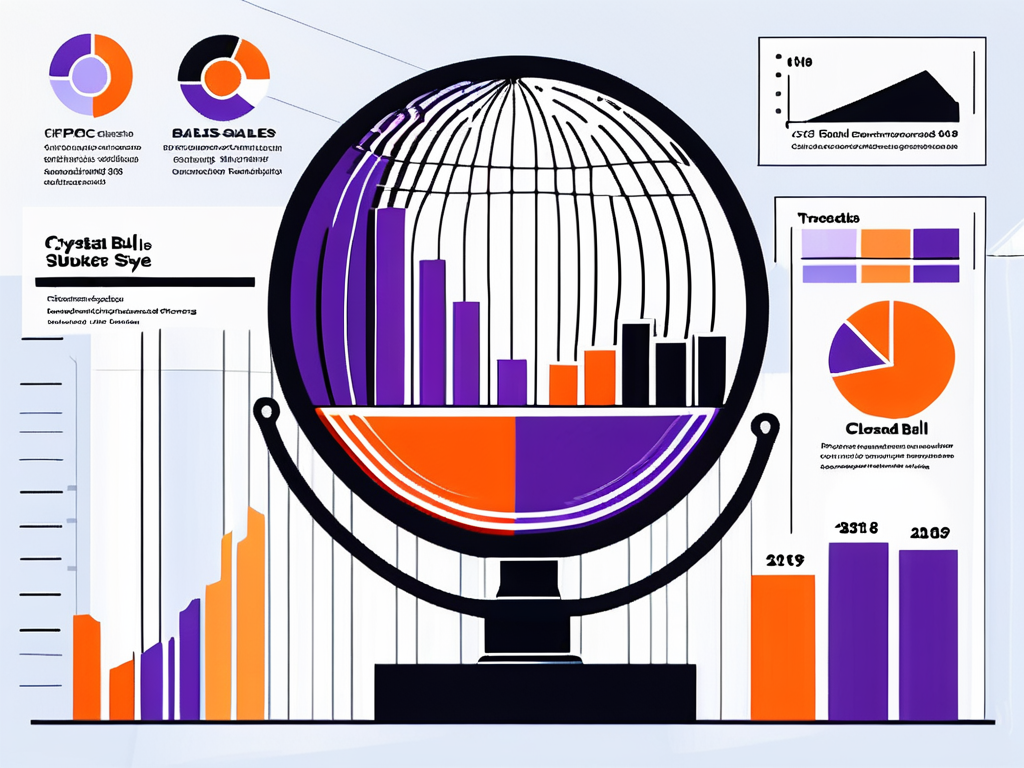According to a recent study, a whopping 75% of FMCG companies struggle with accurately forecasting their sales. With the ever-changing market dynamics and shifting consumer preferences, it’s no wonder many struggle to figure out how to forecast sales in FMCG.
But worry not! In this comprehensive guide, we will unravel the mysteries of sales forecasting and equip you with the tools and knowledge to predict the future with confidence. These will be our key points throughout the article:
- Effective methods for forecasting FMCG sales
- What factors can impact the successful forecasting
- How to set up an effective sales forecasting process
Table of Contents
ToggleBest Methods to Forecast Sales in FMCG
Let’s start with uncovering the different methods used in the FMCG industry to predict sales.

Forecasting sales in the fast-moving consumer goods (FMCG) industry is crucial for strategic planning and decision-making. By accurately predicting sales trends, companies can optimize production, distribution, and marketing efforts to meet consumer demand effectively. Read more on how to improve FMCG demand forecasting accuracy to enhance your business strategy.
Time-Series Forecasting
Time-series forecasting is a popular method used to predict future sales based on historical data patterns. This technique leverages mathematical models to identify:
- Trends
- Seasonal variations
- Other patterns in the data
By extrapolating these patterns into the future, FMCG companies can make accurate sales predictions.
One key advantage of time-series forecasting is its ability to capture the cyclical nature of consumer behavior. By analyzing past sales data over specific time intervals, companies can anticipate seasonal fluctuations, promotional effects, and other recurring patterns that influence sales performance.
Regression Analysis Method
Regression analysis is another powerful tool for sales forecasting in the FMCG industry. It involves analyzing the relationship between various factors, such as:
- Price
- Advertising expenditure
- Sales volume
By quantifying these relationships, FMCG companies can develop regression models that predict sales based on the values of these factors.
Furthermore, regression analysis enables companies to assess the impact of different variables on sales outcomes. By conducting regression diagnostics, FMCG firms can identify significant predictors of sales and refine their forecasting models to improve accuracy and reliability.
Qualitative Forecasting Techniques
Besides relying solely on quantitative methods, FMCG companies often employ qualitative forecasting techniques to complement their sales predictions. Qualitative techniques provide valuable insights into consumer behavior and preferences. These techniques include:
- Expert opinions
- Market surveys
- Customer feedback
By integrating qualitative data with quantitative models, FMCG companies can enhance the accuracy of their sales forecasts.
Qualitative forecasting techniques also allow companies to adapt to changing market dynamics and consumer preferences. By gathering qualitative data from focus groups, social media monitoring, and industry experts, FMCG firms can gain a deeper understanding of emerging trends and consumer sentiment, enabling them to adjust their sales forecasts accordingly.
Implementing a Successful Sales Forecasting Process
Now that we have explored the various methods of sales forecasting in the FMCG industry, let’s shift our focus to implementing a successful forecasting process.
Gathering and Analyzing Data
The first step in the sales forecasting process is gathering and analyzing relevant data. FMCG companies need to collect:
- Historical sales data
- Market research findings
- Other relevant information
By carefully analyzing this data, companies can identify patterns, trends, and correlations that will drive their sales forecasts.
For example, let’s say a company is launching a new line of organic snacks. They would gather data on consumer preferences, market trends, and competitor sales to gain insights into the potential demand for their product.
By analyzing this data, they may discover that there is a growing trend of health-conscious consumers seeking organic snacks, which could indicate a high demand for their new product.
Selecting the Appropriate Forecasting Method
Once the data is analyzed, the next step is to select the most suitable forecasting method for the specific circumstances. Depending on the available data, the nature of the product, and the market dynamics, FMCG companies can choose between time-series forecasting, regression analysis, or a combination of both. It’s important to consider the strengths and limitations of each method to ensure accurate predictions.
Let’s take the example of the organic snack company again. They may decide to use time-series forecasting to predict future sales based on historical data. Additionally, they could use regression analysis to identify the key factors that influence sales, such as:
- Price
- Promotional activities
- Consumer demographics
By combining these methods, they can create a more robust forecasting model that takes into account multiple variables.
Regularly Reviewing and Adjusting Forecasts
Sales forecasting is not a one-time activity but an ongoing process that requires continuous monitoring and adjustment. FMCG companies need to regularly review their sales forecasts and compare them to actual sales figures. By identifying any deviations or discrepancies, companies can fine-tune their forecasting models and improve their accuracy over time.
Continuing with our organic snack example, the company would regularly review their sales forecasts and compare them to actual sales data. If they find that their forecasts consistently overestimate sales, they may need to adjust their model by considering additional variables or refining their data analysis techniques. By continuously improving their forecasting process, they can make more accurate predictions and optimize their production and inventory management.
Why is Sales Forecasting Important in FMCG?
In the fast-paced FMCG industry, where products have a short shelf life and demand fluctuates rapidly, accurate sales forecasting is vital. Learn how inventory management affects FMCG sales forecasting and improves efficiency. It enables companies to anticipate market demand, plan production schedules, optimize supply chain management, and prevent stockouts or excess inventory. By getting a clear picture of future sales, FMCG companies can make strategic decisions to stay ahead of the competition.
Moreover, sales forecasting plays a critical role in new product launches within the FMCG sector. By accurately predicting sales for a new product, companies can:
- Determine the optimal launch strategy
- Allocate resources effectively
- Set realistic sales targets
This is particularly important in a competitive market where the success of a new product can significantly impact a company’s market share and revenue.
Additionally, sales forecasting in the FMCG industry is not just about predicting numbers; it also involves understanding consumer behavior and market trends. By analyzing consumer preferences, purchasing patterns, and external factors such as economic conditions or seasonal variations, companies can fine-tune their sales forecasts to align with changing market dynamics. This level of insight allows FMCG companies to adapt quickly to market shifts and consumer demands, ensuring sustained growth and competitiveness in the industry.
Key Factors Influencing FMCG Sales Forecasting
Now that we have a solid understanding of sales forecasting, it’s time to delve into the key factors that influence sales predictions in the FMCG industry.

Consumer Behaviour
Understanding how consumers react to different products and market trends is crucial for accurate sales predictions. For instance, analyzing data on consumer preferences and buying habits can provide valuable insights into which products are likely to be in high demand and which ones may face challenges in the market. By studying consumer behavior, FMCG companies can adjust their sales forecasts accordingly and make informed decisions about production and distribution.
Seasonal Trends and Their Impact
In the FMCG industry, sales patterns often exhibit seasonal fluctuations. For example, ice cream sales tend to soar during the hot summer months, while hot cocoa sales peak in the winter. Understanding these seasonal trends and their impact on consumer behavior is vital for accurate sales forecasting. By analyzing historical data and studying market trends, companies can adjust their forecasts to account for these seasonal variations. Implementing demand forecasting solutions can enhance accuracy and efficiency in predicting FMCG sales.
Moreover, seasonal trends can also be influenced by cultural and regional factors. For instance, in countries with a strong tradition of gift-giving during festive seasons, FMCG companies can expect a surge in sales for products such as chocolates and luxury goods. By considering these cultural nuances, companies can further refine their sales forecasts and capitalize on seasonal opportunities.
The Role of Market Research
Market research plays a crucial role in FMCG sales forecasting. Companies gain valuable insights that can inform their sales forecastsby collecting and analyzing data on:
- Consumer preferences
- Buying habits
- Market trends
Market research helps identify emerging trends, understand consumer sentiments, and anticipate shifts in demand, enabling FMCG companies to align their strategies and tailor their products accordingly.
Furthermore, market research can also provide insights into the competitive landscape. By studying the market share and performance of competitors, FMCG companies can better understand the dynamics of the industry and make more accurate sales forecasts. This information allows companies to identify potential threats and opportunities, helping them stay ahead in a highly competitive market.
Influence of Promotional Activities
Promotional activities, such as advertising campaigns, discounts, and special offers, can significantly impact FMCG sales. By incorporating these factors into the sales forecasting process, companies can estimate the potential boost in sales resulting from promotions. Moreover, by analyzing the effectiveness of past promotions, FMCG companies can fine-tune their forecasting models to account for the impact of future promotional activities.
It is important to note that the success of promotional activities can vary depending on various factors, such as:
- Target audience
- Timing of the promotion
- Messaging used
By carefully analyzing these factors and incorporating them into the sales forecasting process, FMCG companies can make more accurate predictions and optimize their promotional strategies to maximize sales.
Transform Your FMCG Sales Predictions
So there you have it – a comprehensive guide on how to forecast sales in the FMCG industry. By understanding the basics of sales forecasting, you’ll be well-equipped to navigate the dynamic world of FMCG sales with confidence. Partnering with FMCG fulfillment services ensures streamlined inventory management and demand forecasting.
Remember, accurate sales forecasting is not just a crystal ball – it’s a powerful tool that can drive success and profitability in the FMCG industry, and leveraging Fulfyld can further optimize your supply chain management.






